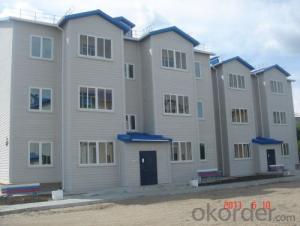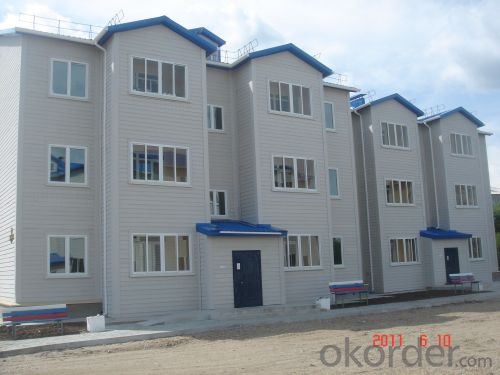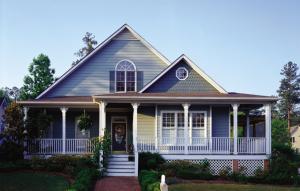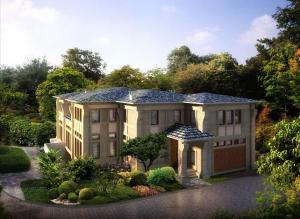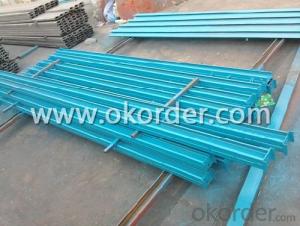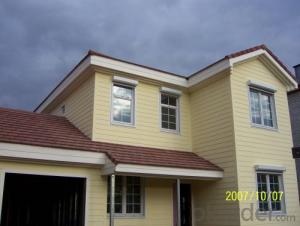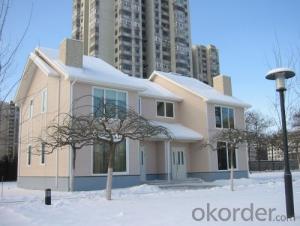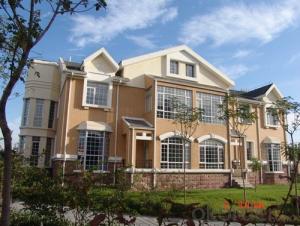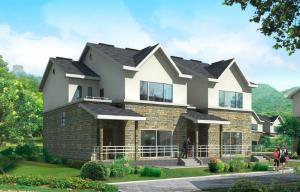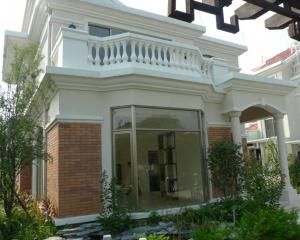Light gauge steel apartment
- Loading Port:
- China Main Port
- Payment Terms:
- TT OR LC
- Min Order Qty:
- -
- Supply Capability:
- -
OKorder Service Pledge
Quality Product, Order Online Tracking, Timely Delivery
OKorder Financial Service
Credit Rating, Credit Services, Credit Purchasing
You Might Also Like
The adavantages of the light gauge steel villa:
1. Better thermal insulation
The advanced exterior overall thermal insulation meets the updated state energy-saving standards for buildings. It refrains from the cold and thermal bridges phenomenon, and keeps buildings away from damages such as dampness, distortion, mildew and corrosion.
The unique heat reflection and ventilation layer design can make better insulation effects. Temperature can be reduced by five to eight degrees. ( In my opinion, this advantage is very suitable for the climatic condition of Middle East )
2. Seismic and Wind Resistance
Withstand the shock of 9 on the Richter scale. The dense light gauge steel and column are connected in flexible method with screws and bolts, which can abosorb the energy of eathquake. There are fittings between foundation and wall, which are resistant to pull out and shear. The total weight of the house is light, which is only 1/6 of the conventional concrete houses. Therefore it has better anti-seismic performance.
Can endure typhoon of 12 levels
There are special fittings among roof, floor, wall and foundation. The strong connection can help resist typhoon of 12 levels.
3. Roof Load-bearing and Fireproof
The structure can be designed according to climate requirements.
Wall and floor slab use special technology which can meet 3h refractory limit.
4. Sound insulation
Improved technology on sound insulation and shock absorption meet the state building standards for sound insulation. Special methods are performed, especially towards the audio frequency ranging from 250-1000Hz which is the most sensitive to ears, in order to create a quiet and comfortable living environment.
5. Moisture-proof and Ventilation
There is a gap between wall and roof truss, so the air can flow inside.
There is one-way ventilation layer in the composite wall, which is able to make the wall "breath". This means moisture can be reduced inside the door.
6. Durable (90 years structure safty guarantee)
Special coating technology enables the structural materials to have the self-restoration function to prevent rust and corrosion.
Envelope materials using new light weight building materials to achieve fire resistant, anti-corrosion and anto-moth.
7. Energy Efficient and Enviromental Protection
Energy Saving: 65-90 energy redution.
Water Saving: The dry construction consumes 10% of water used in traditional constrution.
Land Saving: The inside usable area increases 10%
Environment Protection: Pollution-free construction system.
- Q: Are container houses suitable for campgrounds or glamping sites?
- Campgrounds or glamping sites can consider container houses as a viable option. These houses provide several advantages that make them perfect for such accommodations. Firstly, containers are resistant to weather and durable, which makes them suitable for outdoor environments. They can endure harsh weather conditions, ensuring the safety and comfort of guests. Furthermore, container houses are easily transportable and can be set up with ease, allowing for flexibility in terms of location and design. They can be tailored to create distinct and visually pleasing accommodations, enhancing the glamping experience. Additionally, container houses are environmentally friendly as they repurpose unused shipping containers, reducing waste and promoting sustainability. They can be equipped with eco-friendly features like solar panels and rainwater harvesting systems, further enhancing their suitability for campgrounds or glamping sites. All in all, container houses offer a cost-effective, durable, flexible, and eco-friendly solution for campgrounds and glamping sites, making them a suitable choice for these types of accommodations.
- Q: What is the origin of the name of the office?
- In accordance with the name of Hong Kong and Taiwan, the office called the office, then the office building will naturally become a office.
- Q: Can container houses be designed to have a separate home office space?
- Indeed, it is conceivable to fashion container houses with a distinct area for a home office. The versatility of container houses renders them adaptable and open to customization in order to fulfill particular desires and requirements. By meticulously plotting the arrangement and design, it becomes feasible to establish a dedicated portion within the container house that fulfills the purpose of a home office. This objective can be accomplished through the act of partitioning a segment of the container, incorporating doors or walls to ensure privacy, and integrating essential amenities including electrical outlets, lighting fixtures, and internet connectivity. Moreover, container houses possess the potential for expansion or alteration by connecting multiple containers, thereby amplifying the potential for creating an independent home office space.
- Q: Can container houses have multiple stories?
- Yes, container houses can have multiple stories. Contrary to popular belief, container houses are not limited to just one level. With the right design and structural modifications, containers can be stacked on top of each other to create multiple stories. By using proper reinforcements, such as additional steel beams and columns, it is possible to create a stable and secure structure that can support multiple levels. Additionally, container houses can also be expanded horizontally by adding additional containers side by side. This versatility allows for the creation of container homes with multiple stories, providing more living space and accommodating larger families or diverse needs.
- Q: Can container houses be customized to fit individual preferences?
- Yes, container houses can definitely be customized to fit individual preferences. One of the key advantages of building a home using shipping containers is the flexibility it offers in terms of design and customization. Since containers are modular in nature, they can be easily modified to suit specific preferences, needs, and requirements. Container houses can be customized in various ways. Firstly, the interior layout can be tailored to fit individual preferences. The containers can be combined or stacked to create multiple levels or open spaces. Walls can be added or removed to create rooms or open-concept living areas. The placement of windows, doors, and other openings can also be customized to maximize natural light and views. Secondly, container houses can be customized in terms of aesthetics. The exterior of the containers can be painted or clad with different materials to achieve the desired look. This allows for a wide range of design options, from modern and minimalist to rustic and industrial. Additionally, various finishes, colors, and materials can be used for the interior to create a personalized and unique living space. Furthermore, container houses offer flexibility when it comes to additional features and amenities. For instance, individuals can choose to include solar panels for sustainable energy, incorporate a green roof for improved insulation and environmental benefits, or install smart home technology for convenience and efficiency. Overall, container houses provide ample opportunities for customization. They can be adapted to fit individual preferences in terms of layout, design, and additional features. Whether someone desires a contemporary, traditional, or unconventional style, container houses offer the flexibility to create a personalized living space that matches individual tastes and requirements.
- Q: Can container houses be designed with a contemporary or futuristic look?
- Yes, container houses can definitely be designed with a contemporary or futuristic look. Although the use of shipping containers may evoke a sense of industrial or rustic aesthetics, with the right design elements and architectural techniques, container houses can be transformed into sleek and modern homes that exude a contemporary or futuristic vibe. Designers can incorporate various elements to achieve a contemporary or futuristic look in container houses. This could involve using sleek and minimalistic finishes, such as smooth metal or glass exteriors, to create a clean and modern appearance. Additionally, the strategic placement of windows and skylights can maximize natural light and create an open and airy feel, further enhancing the contemporary design. Furthermore, incorporating cutting-edge technologies and innovative building materials can lend a futuristic touch to container houses. For instance, incorporating smart home features, energy-efficient systems, and sustainable materials can not only add a futuristic aspect but also contribute to a more environmentally friendly design. The key to achieving a contemporary or futuristic look in container houses lies in the creativity and vision of the architect or designer. By pushing the boundaries of traditional container house design and exploring new possibilities, container homes can be transformed into stunning, forward-thinking living spaces that reflect the aesthetics of the present or even anticipate the design trends of the future.
- Q: How are container houses different from traditional houses?
- Container houses are constructed using shipping containers, which are repurposed and transformed into livable spaces. Unlike traditional houses, container houses are pre-fabricated, meaning they are built off-site and then transported to the desired location for assembly. Additionally, container houses are typically more cost-effective, sustainable, and can be easily transported or relocated. However, they often have limited space and may require additional insulation and customization to meet individual needs and preferences.
- Q: Can container houses be designed to have a small backyard or garden space?
- Certainly, it is possible to design container houses with a small backyard or garden area. The adaptability of container houses permits various design possibilities, including the integration of outdoor spaces. Architects and designers can strategically position and manipulate the containers to create functional and visually appealing outdoor areas. One method involves arranging the containers in such a way that a central open space is formed, which can be used as a courtyard or a small backyard. This area can serve multiple purposes, such as gardening, relaxation, or an extension of the living area. The containers themselves can function as walls or partitions, ensuring privacy and defining the outdoor space. Another option is to utilize rooftop gardens. Containers can be stacked or positioned in a manner that creates a flat roof, which can then be converted into a green area. Rooftop gardens not only allow for gardening but also contribute to insulation, rainwater collection, and even energy efficiency. Furthermore, containers can be modified to include built-in planters or vertical gardens. By attaching planter boxes or implementing a trellis system, container houses can incorporate greenery even in limited spaces. These planters can be filled with herbs, flowers, or even small trees based on the homeowner's preferences. Overall, container houses offer design flexibility, enabling the inclusion of small backyard or garden spaces. Through thoughtful planning and innovative solutions, homeowners can enjoy outdoor areas that enhance their living experience while making the most of the available space.
- Q: Are container houses suitable for mountainous regions?
- Container houses are a perfect choice for mountainous areas due to their strong structure and long-lasting nature. They can withstand tough weather conditions and heavy snow loads, making them a reliable housing option. This is especially important in regions where traditional construction materials may not be as sturdy. Furthermore, container houses are easily transportable and can be installed in remote locations, which is often the case in mountainous areas. Their modular design allows for effortless assembly and disassembly, making them ideal for places that are hard to reach. Additionally, their compact size makes them suitable for small plots of land commonly found in mountains. Moreover, container houses can be designed to be eco-friendly and energy-efficient. They can be equipped with insulation, solar panels, and other sustainable features, ensuring that they can withstand the challenging climate conditions of mountainous regions. Not only do they provide a comfortable living environment, but they also reduce the ecological impact of residents. In conclusion, container houses are indeed a suitable housing solution for mountainous regions. Their durability, mobility, and adaptability make them an excellent choice for overcoming the unique challenges of living in rugged terrains.
- Q: What is the price of container housing?
- Luxury point, it may be two containers up and down together, so there is a balcony, a large living room
Send your message to us
Light gauge steel apartment
- Loading Port:
- China Main Port
- Payment Terms:
- TT OR LC
- Min Order Qty:
- -
- Supply Capability:
- -
OKorder Service Pledge
Quality Product, Order Online Tracking, Timely Delivery
OKorder Financial Service
Credit Rating, Credit Services, Credit Purchasing
Similar products
Hot products
Hot Searches
Related keywords
